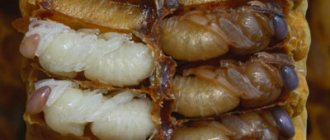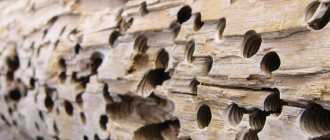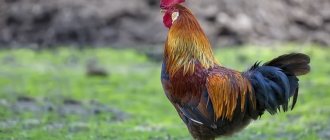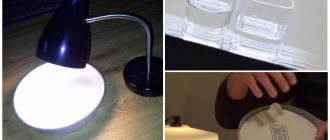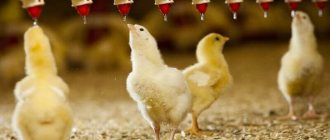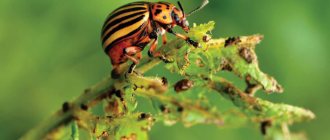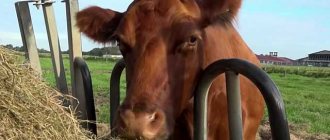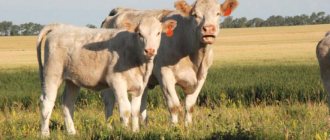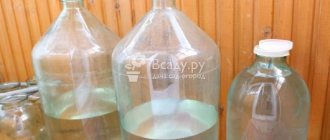As you know, raising goats involves obtaining not only milk and meat, but also high-quality warm skins. Naturally, in order to get good fur you will need certain skills and knowledge. In order for even a beginner to be able to repair a goat skin the first time, we offer the following material, in which we will tell you how to correctly perform this procedure at home on your own.
Characteristic features of hide products
The demand for goat skins is very high today. Compared to sheepskin, goats produce denser, stronger and more elastic products. The resulting products are warm, light and beautiful.
The skin obtained from young animals becomes chevro, mouflon and other fur and leather semi-finished products.
recommended articles:
- Feeding Muscovy ducks at home: selection of diet and supplements
- Warm bedding for chickens in winter: choosing the best option
Goat skin
The weight of paired products is up to 6% of the total weight of the goat; other indicators will depend on the breed characteristics and age category. From an adult animal you can get a canvas that will have an area of more than a hundred square centimeters (in young animals it is approximately ¼ of the indicated size).
Based on thickness, paired skins can be divided into the following groups:
- 1.8 – 2.5 mm – adult goat;
- 2.2 – 3.5 mm – adult goat;
- 0.9 – 1.4 mm – young animals 60 – 90 days;
- 1.3 – 2.2 mm – young animals 150 – 180 days.
The quality of the raw materials depends on the conditions provided to the animals. With a lack of food, the skin becomes thin and flabby. If there was an infectious or parasitic infection, then the skin is dry and the fur comes out in clumps.
How to skin
Goat skins are removed using a certain technology called “plastic”. Initially, it is necessary to hang the carcass and make three cuts:
- Transverse. Starts from any of the hooves of the hind limbs to the second hoof (the incision goes along the anus).
- Transverse. It starts from the metacarpal joint on the forelimb and extends to the same joint of the second hoof through the sternum.
- Longitudinal. From the throat part of the carcass through the sternum and belly area, ending at the middle part of the tail.
Removing the skin of a goat
After completing these steps, you can remove the skin, adhering to these simple rules:
- the skin is pulled away from the carcass, starting from the neck region, and then from the forelimbs;
- You need to pull carefully with your hands until it comes off, avoiding sticking of fat and lard.
In some areas, the skin and the body may have a very tight bond: here you can carefully trim the problem area. It is very important not to damage the valuable fur. An additional incision is made near the anus and around the loop (in goats). After the removal of the skins reaches the hind limbs, the pulling stops until additional cuts are made, then continues again.
In areas where lard and fat accumulate, you can also use a knife so that they do not come off, but remain on the meat.
After the goat is finally skinned, it must be laid out or stretched using a special frame, which allows the raw material to dry without losing its configuration.
In the following table you can see the characteristics of hide products depending on the time of slaughter:
| Type of skins | Slaughter time (months) | How is it characterized | Where is it used? |
| Summer | 6-7 | Low grade, no fatty inclusions. Coat – sparse, short, no fluff | Shoe manufacturing, haberdashery products |
| Autumn | 8-10 | Durability – medium, coat – in moderate amount, there is a slight shine | Shoemaking, haberdashery, lining, clothing |
| Winter | 11-1 | Very durable, shiny. Coat – thick with fluff | Sewing linings, fur clothing, shoes |
| Spring | 2-5 | Low-grade, because the coat is changing. Thin skin. There are bald patches on the fur | Not suitable for industrial use |
To obtain hide products of the highest quality, dressing should be carried out immediately after it has been removed.
In most cases, it is not possible to do this right away, and therefore you will have to carry out the initial preservation process using dry salt.
Skin dressing
Additional processing
The completely dried goat is laid out on the floor, flesh side up, and inspected for any remaining unevenness or film. Such flaws cannot be left, as they will interfere with the plasticity of the fabric and create defects when sewing products.
Defects are removed with sandpaper or a scythe, throwing the material over the deck. It is important to avoid tears and holes. As a result, the skin should stretch freely in all directions and be smooth and soft to the touch.
It is better to comb the goat's wool. This will protect the hairs from caking. Excess dust or trapped dirt can be cleaned out during the process. Carpet cleaner is applied to the pile. Then it is combed out with a brush. The skin will look polished and well-groomed.
The pile needs to be combed
In some cases, dyeing may be required. Depending on the pigment, it can be carried out before or after fatliquoring. Color helps to hide minor defects, imitate more expensive fur (otter, seals, etc.), and stylize future items. For dyeing, pigments of natural (sumac, indigo, turmeric, inknut, blue (campesh) and mahogany) or synthetic (oxidative dyes, aniline dyes, vat pastes and powders) origin are used. The application technique can be soaking or using a large brush (brush).
Dyed goat products
As a result of experimenting with the palette, you can get a goat of a unique, attractive color. After painting, thorough drying is also required.
Initial conservation
This method will help preserve the hide products until dressing, and dry salt is used here. In simple terms, banal salting is carried out using the following technology:
- After removal, the skin is laid out on a flat surface, skin side out.
- Use sharp tools to scrape off stuck-on meat.
- It is necessary to cover the entire skin with dry salt, not forgetting the edges.
- Then place the workpiece in an envelope so that the skin lies against the skin and not against the fur.
- Fold the skin in half and place it in any container for three days.
- As soon as this time has expired, you need to unfold the skin and hang it on a horizontal bar with the fur inward so that the fold goes along the ridge.
- Hide products are stored in dry rooms.
This primary processing allows you to store the workpieces for a very long time, the main thing is to ensure that there are no moth attacks on the wool.
Step-by-step instructions for dressing
The highest quality goat skin is obtained if it is tanned immediately after removal, when it is still “warm”. However, this opportunity is rarely provided, so its primary conservation is often carried out. Let us note that dressing the skin is a very complex and labor-intensive process. This is why many owners of fur-bearing animals most often hand over their material to a specialist for dressing, rather than try to do everything at home themselves. But there are not so many of them and not all regions have them. Therefore, knowledge of how to properly carry out this entire process will also be useful.
Conservation
The most popular method for preserving skins and skins until dressing is dry-salted preservation. What does it mean? This is a kind of salting of the skin. To do this, the fresh skin needs to be laid out on the floor or on a table with the fur inward, that is, the flesh (skin) facing up. If there are any remaining meat, they need to be scraped off with a sharp knife. Then we take salt and sprinkle it over the entire skin, especially the edges. Then we fold the material into an envelope so that the core is on the core. And once again fold the skin in half and leave it in a convenient container for about three days.
After this, the material must be hung horizontally with the skin up along the ridge line and stored in a dry room. It is best, as practice shows, to go into the attic. In this form, the skin can be stored for a long time, however, you need to be careful not to get moths.
Soaking
This process is carried out for hides that have undergone primary processing in the form of preservation. But in order to carry out further processing, you need to soften the material. The procedure is carried out as follows:
- You need to get a container of a suitable size where the skin will remain for three to four days.
- It is advisable to use only soft water. To soften hard water, you need to use alkali.
- The amount of liquid is calculated as follows: the mass of dry material multiplied by 6.
- While the soaking procedure is in progress, you need to maintain a temperature of 15 degrees.
To avoid the proliferation of putrefactive bacteria and speed up the process, you can use aggravators (special compounds added to the liquid):
- table salt – 5 grams per liter of water;
- soda ash – 1 gram/liter.
How to properly preserve and soak
For preservation, the skin is initially cooled, straightening the skin downwards, and hung for half an hour.
- Then you will need a couple of kilograms of salt so that the entire surface is completely covered.
- The goat should lie like this for three or four days.
- The remaining salt is then removed, and the hide is dried on a wooden pole.
- You can add additional flour to the salt, then the quality of preservation will be ensured to the maximum.
To carry out soaking in water for four, use containers of suitable depth. After that, a dead end or a braid is used to trim the skin.
The procedure is carried out once over two days to remove excess thickness along with subcutaneous fat. The speed of the process depends on the water temperature. By adding salt, you can speed it up further.
How to properly perform fleshing and breakdown
Scraping Sticky Meat
Residual subcutaneous layer and fiber must be removed from the skin. To produce the material, special equipment is used in the form of a machine, which has a shaft and blades in the form of screws. You can also use a sharp scythe.
The technology looks like this:
- It is necessary to install a deck that has a slope of 35 degrees.
- Place the skin skin side up.
- Using a sharp knife, carefully begin scraping off the entire top layer.
- Scrape from the middle to the left hind limb.
- From the central part to the right leg.
- After the back of the skin has been processed, you need to turn it over and repeat everything.
Flesh
You can remove one or two goat skins in any way: on a scythe, on a staple, on a block. In the case of a large number of skins, the fleshing process needs to be mechanized. For these purposes, a disk peeling machine or a roller machine is used. The skins are cleaned of fat and meat trimmings, thick parts are cut to thickness. After such an operation, the penetration of chemicals in liquid solutions is accelerated.
The stripped skins are washed in a solution at a temperature of 35 degrees with 2 g/l powder for 30 minutes. Then rinse in clean warm water. After washing, the pickling process begins.
Fleshing the skin with a scraper
Pickling technology
This process is carried out after removing the top layer of skin. Hide products are treated with a solution of water with various acids and table salt. As a result of the process, the skin acquires plasticity and softness.
At home you can use the following acids:
- vinegar;
- sulfur;
- salt;
- formic.
Table salt plays the role of affecting acids. The lack of this component leads to the destruction of the skin.
To prepare the solution, use the following recipe:
- acid is taken in the amount of 9 grams per 1 liter of water;
- salt – 60 grams/liter;
- water temperature – 25 degrees.
In another way, this process can be called treating the skins with a special aqueous solution with acid.
Tanning goat skin at home
To obtain high-quality goat meat, it is necessary to strictly follow the technological process of its production and processing. It is carried out in several stages, each of which has its own characteristics.
- Conservation
Immediately after removing the skin, it must be cooled. To do this, straighten it with the pile down and leave it in this position for thirty minutes. After this, the surface of the goat is covered with salt (at the rate of one and a half to two kilograms per piece) and left in a cool room for three to four days. After this, the remaining salt must be removed and the skin dried by hanging it on a flat wooden pole.
Sometimes, for better preservation, the skins are sprinkled with flour along with salt (300-500 grams per square meter of skin).
- Soak
Most often, soaking is done in deep containers. Soaking lasts from two to four days with fleshing every two days. After soaking the skin, it is also necessary to skin it with a scythe or a dead end on a special block.
Soaking is a special treatment in water, in which the entire fabric is hydrated and dirt, concentrates and protein substances are removed from it. During soaking, the dermis swells, and the speed of the process is affected by the temperature of the water.
Note: To prevent rotting of the skin and liquid, any antiseptic solution (zinc chloride, formaldehyde) is added to the water. However, too much soaking is not good, since it results in overheating - a strong and sharp increase in tissue with a change in its structure. To prevent this process, neutral salts (sodium chloride or sodium hydrogen sulfate) are added to the water.
In addition, the addition of salts allows you to speed up the soaking process and remove protein substances from the skin, which increases the permeability of goat meat.
The soaking procedure depends on the type of raw material preservation:
- For wet-salted raw materials, no additional solutions are required. The skins are simply washed in clean water for several hours.
- Quick soaking is also possible for skins that were preserved by pickling. But in this case you need to be extremely careful, since they quickly become waterlogged, losing a large amount of interfiber proteins during fermentation.
- When carrying out soaking for skins preserved by the acid-salt method, the raw materials are first washed with clean water in order to properly degrease them later.
- Soaking dry-salted and fresh-dry raw materials is considered the most difficult. There is a lot of water in such skins, so the first soaking period is enhanced by the high temperature of the liquid, to which antiseptics and accelerators are necessarily added.
During the soaking process, periodic fleshing is mandatory (once every two days). The procedure involves removing the subcutaneous fat layer and eliminating excess thickness. Fleshing can be done manually or using special machines.
- Wool cutting
To carry out this procedure, quicklime and sodium sulfide are used. These two substances are mixed in a separate container until a liquid is obtained, the consistency of which resembles oil paint. Next, the mixture is applied to the goat using a broom or roller, the skins are twisted, placed in one pile and covered. In this way, the raw materials are stored for 18 hours, after which the skins are unrolled and the wool is removed by hand or with a special tool, a dead end. After completing the cutting of wool, the raw material must be additionally rinsed in warm, clean water for 20-30 minutes.
- Liming
The skins should remain in the ash liquid for about two days. To prepare the solution, take 4 g of sodium sulfide and 8 g of quicklime for each liter of liquid. The proportion for liming is 4 liters of ash liquid per 1 kg of raw materials.
- Stripping
After liming, it is necessary to clean the goats. To do this, they are removed from the solution, allowed to drain (for an hour), after which they are washed for 15 minutes in warm, clean water. Stripping is carried out using a dead end on a special deck (Figure 1).
- Flushing
The washing procedure is carried out twice. I use only clean water (at the rate of 4 liters of water per 1 kg of goats). The skins are washed for twenty minutes.
- Deliming and softening
The process of deashing goats is carried out in water with a solution of ammonium sulfide or ammonium sulfate (the proportion of the additive is 1.2 percent of the total volume of liquid). Deashing lasts for one and a half hours. During this time, the skins need to be mixed three times.
Figure 1. Processing goat meat at home
Softening is carried out using shakshas made from chicken or pigeon droppings. For softening, you need to prepare in advance, about two days in advance. A bucket of dry droppings is steamed with 15 liters of boiling water. Next, this mass must be dissolved in one hundred liters of water. It is in this liquid that the goats are immersed for 18-20 hours, stirring them periodically. After the skins have been lying in the solution, they are taken out, allowed to drain, and additional cleaning of the inside and front part is carried out using a dead end.
- Pickling
Pickling is a dressing operation that is intended for the production of goat meat. It is pickling that can be considered the main dressing process, due to which a change in their structure occurs, necessary for the further production of leather and fur products.
Note: After treating goat meat with pickel solution, the ability of the fibers to bond decreases, the skin becomes more elastic, soft and viscous. The pickling solution contains an acid and a neutral salt, but sodium chloride must be added to it to prevent the skins from burning. Acetic or sulfuric acid is often used for pickling.
There are two main methods of pickling: spread and dipping. The latter is more popular, since the skin is simply immersed in a vat and stirred periodically. When using the spread method, the skins are coated with a solution on the skin side, and the mixture for pickling should be more concentrated. Next they are laid out for storage.
- Tanning
After pickling, the leather becomes soft and elastic, but its strength may be impaired in the finished product under the influence of rain or snow. That is why another procedure is used - tanning. The main purpose of this process is to make the hides more resistant to moisture, heat or chemicals.
Tanning of goats is carried out in a previously used pickling solution, to which a tanning solution is added (oak bark or extract in a proportion of 5 g per 1 liter of water. However, the most effective is considered to be the composition of their chromium, water and sulfuric acid. To prepare the solution you need to take one part of potassium or sodium chrompic, one and a half parts of sulfuric acid and 3.15 parts of water. First, pour the acid into the water, then add chrompic and add bread flour in small batches. The tanning composition will be ready for use when it becomes thick and dark green. The mixture can be started use within 12 hours after preparation (20 ml of the mixture is diluted in a liter of water).
What is tanning
After the above process is completed, the hide product will become soft and elastic, but when soaked it will become hard again. To prevent this, tanning is carried out.
There are several methods, but in households the most widely used method is the aluminum-chrome method using alum.
To prepare the solution, you can use the following recipe:
- salt – 50 grams;
- hyposulfite – 10 grams;
- chrome alum – 4 grams;
- aluminum alum - 1.5 grams;
- soda ash - 0.5 grams.
This amount is applied per liter of warm liquid.
The tanning technology looks like this:
- Initially, salts with hyposulfite are diluted with water.
- The skin is placed in the solution until it is completely saturated. The first 45 minutes require periodic stirring.
- After 120 minutes, chrome alum should be added and divided into 2 portions. First, one is added, after 60 minutes - the second.
- After another 60 minutes, the turn of the aluminum alum solution comes.
If everything went well, the skin turns green, after which it needs to be dried.
Rules for drying the finished product
The skin should be dried in the shade with the inside out, periodically kneading and stretching it. Air drying takes about 3 days. In total, dressing sheep skins takes several days. To speed up drying, household appliances are sometimes used. You can spin the item in a centrifuge. Drying is carried out in a drying chamber at a temperature of about 40°C.
To improve the quality of the product, it must be treated with a mixture of glycerin and salt, ammonia and egg yolk. For 25 g of glycerin you need to take 100 g of salt, 20 g of alcohol and 70 g of yolks. The mixture is evenly applied to the flesh. The surface becomes soft and shiny. Products made from skins tanned at home can be proudly used later.
To obtain finished leather, the process must begin in the same way as tanning hides. But after cleaning and salting, the wool is removed. To do this, use a mixture of sodium sulfide and quicklime. The lime must first be quenched with water.
Drying will dissolve the hair and the fur can be scraped off the skin with a dull knife. The chemicals are then neutralized using ammonium sulfate. Everything is washed thoroughly. Tanning occurs with chrome plating, which gives strength to the leather, and sulfur gives softness. Chromium plating involves potassium chromium and acid. Next, neutralization with borax is carried out. Again a good rinse with soaking is required. Dry the resulting products and soak them in fat. People acquired the skill of how to repair a hide through experience and passed it on from generation to generation.
What is the essence of fattening?
Here the skin is given even greater softness and elasticity. To carry out the process, you need to make an emulsion that has a temperature of approximately 45 degrees and consists of the following ingredients:
- pork or lamb lard – 450 grams;
- fish oil – 50 grams;
- ammonia – 25 ml of 25% concentration.
A thick layer of ointment should be applied to the entire surface of the skin and allowed to be absorbed. The process takes up to 8 hours. Then the skin needs to be dried and stretched in length and width using special brackets.
Processes of degreasing, neutralization, coloring
Kerosene or gasoline is an excellent means for degreasing. One and a half liters of solution with water will be enough for one square meter. They lie there for about two hours, then they will need to be washed three times for half an hour in warm water.
For neutralization, use soda ash (soda ash) dissolved in water. The procedure is carried out twice for about twenty minutes.
A certain color is given to the skins by dyeing, for which various (synthetic and natural) dyes are used.
- The final stage is fatliquoring. When substances are injected into the skin, covering the surface with a thin film of fat.
- Only in this case the fabric fibers will not be able to stick or curl. The skin acquires a pleasant softness, along with strength and plasticity.
- For this purpose, mineral oils, as well as animal or vegetable fats can be used.
Why do they clean up?
After the skin has stretched, it must be removed and inspected for uneven spots and film that can affect the plasticity of the product. To correct identified deficiencies, use a block and a sharp knife for stripping (it can be replaced with sandpaper). Properly cleaned leather has a soft and smooth surface. All that remains is to carry out the stage of combing the fur.
What is made from goat skins?
Animals of any age group can be used for skinning. The lower the age limit, the easier it is to carry out the dressing. Hide products are divided into the following types:
- Whipping - obtained from unborn kids.
- Opoek is a newborn goat.
- Outgrowth – animals 90 days.
- Neblyuy is the skin of 180-day-old animals.
- Half-skin – 365 days.
The first two types are purchased for the production of thin husky for gloves. The third type is an expensive chevro. The remaining two are valued for their softness and strength.
The quality of hide products will depend on the breed, living conditions, age group and feeding diet.
We invite you to join our Zen channel and group on VKontakte or Odnoklassniki, where new articles are published, as well as news for gardeners and livestock breeders.
Similar articles:
- At what age should a goat be covered?
- How to get odorless goat meat?
- Signs of vitamin deficiency in goats in the winter-spring period


